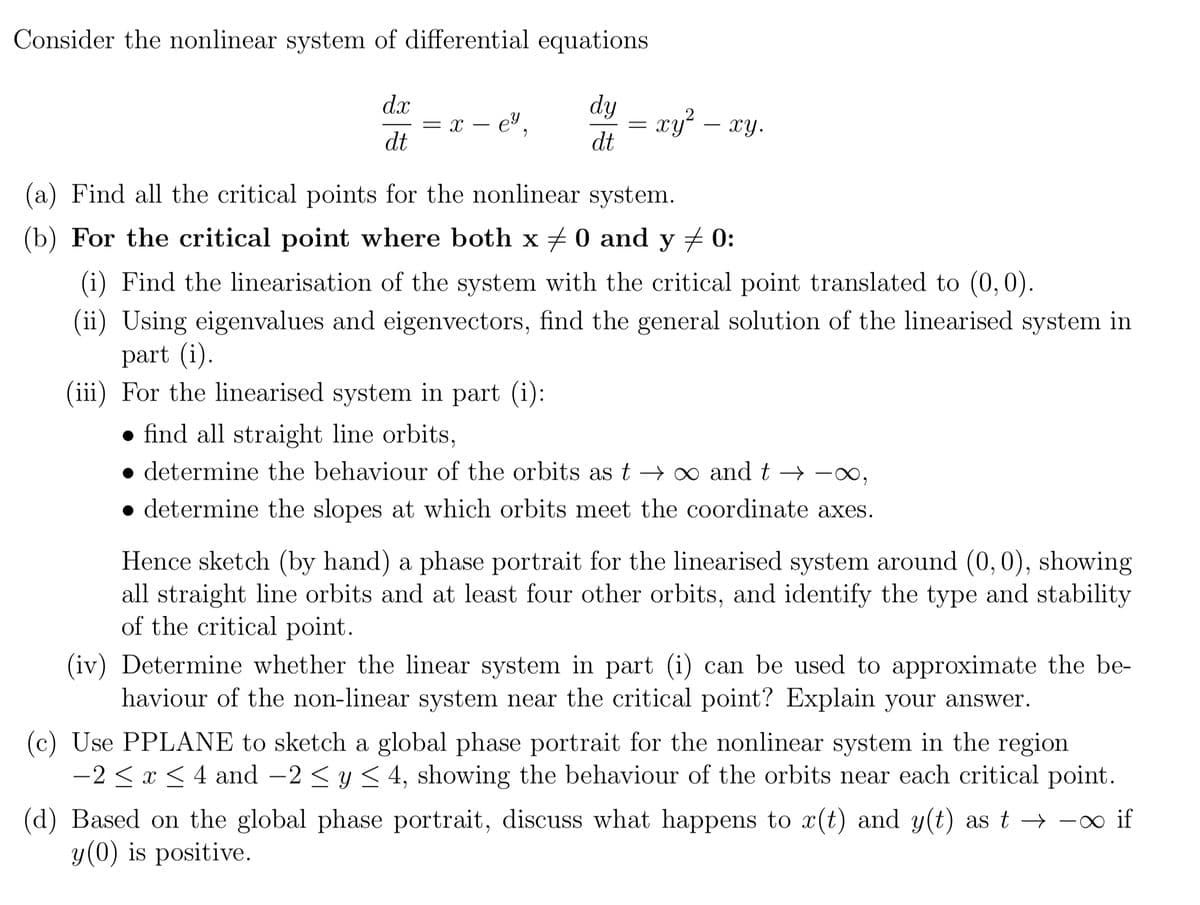Consider the nonlinear system of differential equations dy dt dx dt = x - e², xy² - - xy. (a) Find all the critical points for the nonlinear system. (b) For the critical point where both x 0 and y = 0: (i) Find the linearisation of the system with the critical point translated to (0,0). (ii) Using eigenvalues and eigenvectors, find the general solution of the linearised system in part (i). (iii) For the linearised system in part (i): find all straight line orbits, determine the behaviour of the orbits as t→∞ and t→→∞, • determine the slopes at which orbits meet the coordinate axes. Hence sketch (by hand) a phase portrait for the linearised system around (0, 0), showing all straight line orbits and at least four other orbits, and identify the type and stability of the critical point. (iv) Determine whether the linear system in part (i) can be used to approximate the be- haviour of the non-linear system near the critical point? Explain your answer. (c) Use PPLANE to sketch a global phase portrait for the nonlinear system in the region -2 ≤ x ≤ 4 and -2 ≤ y ≤ 4, showing the behaviour of the orbits near each critical point. (d) Based on the global phase portrait, discuss what happens to x(t) and y(t) as t → ∞ if y (0) is positive.
Consider the nonlinear system of differential equations dy dt dx dt = x - e², xy² - - xy. (a) Find all the critical points for the nonlinear system. (b) For the critical point where both x 0 and y = 0: (i) Find the linearisation of the system with the critical point translated to (0,0). (ii) Using eigenvalues and eigenvectors, find the general solution of the linearised system in part (i). (iii) For the linearised system in part (i): find all straight line orbits, determine the behaviour of the orbits as t→∞ and t→→∞, • determine the slopes at which orbits meet the coordinate axes. Hence sketch (by hand) a phase portrait for the linearised system around (0, 0), showing all straight line orbits and at least four other orbits, and identify the type and stability of the critical point. (iv) Determine whether the linear system in part (i) can be used to approximate the be- haviour of the non-linear system near the critical point? Explain your answer. (c) Use PPLANE to sketch a global phase portrait for the nonlinear system in the region -2 ≤ x ≤ 4 and -2 ≤ y ≤ 4, showing the behaviour of the orbits near each critical point. (d) Based on the global phase portrait, discuss what happens to x(t) and y(t) as t → ∞ if y (0) is positive.
Advanced Engineering Mathematics
10th Edition
ISBN:9780470458365
Author:Erwin Kreyszig
Publisher:Erwin Kreyszig
Chapter2: Second-order Linear Odes
Section: Chapter Questions
Problem 1RQ
Related questions
Question

Transcribed Image Text:Consider the nonlinear system of differential equations
dy
dt
dx
dt
= x - e²,
= xy² — xy.
=
(a) Find all the critical points for the nonlinear system.
(b) For the critical point where both x = 0 and y ‡ 0:
(i) Find the linearisation of the system with the critical point translated to (0,0).
(ii) Using eigenvalues and eigenvectors, find the general solution of the linearised system in
part (i).
(iii) For the linearised system in part (i):
find all straight line orbits,
determine the behaviour of the orbits as t→∞ and t→→∞,
• determine the slopes at which orbits meet the coordinate axes.
Hence sketch (by hand) a phase portrait for the linearised system around (0, 0), showing
all straight line orbits and at least four other orbits, and identify the type and stability
of the critical point.
(iv) Determine whether the linear system in part (i) can be used to approximate the be-
haviour of the non-linear system near the critical point? Explain your answer.
(c) Use PPLANE to sketch a global phase portrait for the nonlinear system in the region
-2 ≤ x ≤ 4 and -2 ≤ y ≤ 4, showing the behaviour of the orbits near each critical point.
(d) Based on the global phase portrait, discuss what happens to x(t) and y(t) as t→ ∞ if
y (0) is positive.
Expert Solution
This question has been solved!
Explore an expertly crafted, step-by-step solution for a thorough understanding of key concepts.
This is a popular solution!
Trending now
This is a popular solution!
Step by step
Solved in 5 steps with 3 images

Recommended textbooks for you

Advanced Engineering Mathematics
Advanced Math
ISBN:
9780470458365
Author:
Erwin Kreyszig
Publisher:
Wiley, John & Sons, Incorporated

Numerical Methods for Engineers
Advanced Math
ISBN:
9780073397924
Author:
Steven C. Chapra Dr., Raymond P. Canale
Publisher:
McGraw-Hill Education

Introductory Mathematics for Engineering Applicat…
Advanced Math
ISBN:
9781118141809
Author:
Nathan Klingbeil
Publisher:
WILEY

Advanced Engineering Mathematics
Advanced Math
ISBN:
9780470458365
Author:
Erwin Kreyszig
Publisher:
Wiley, John & Sons, Incorporated

Numerical Methods for Engineers
Advanced Math
ISBN:
9780073397924
Author:
Steven C. Chapra Dr., Raymond P. Canale
Publisher:
McGraw-Hill Education

Introductory Mathematics for Engineering Applicat…
Advanced Math
ISBN:
9781118141809
Author:
Nathan Klingbeil
Publisher:
WILEY

Mathematics For Machine Technology
Advanced Math
ISBN:
9781337798310
Author:
Peterson, John.
Publisher:
Cengage Learning,

